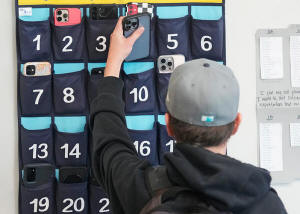Half of US states now have laws banning or regulating cellphones in
schools, with more to follow
[May 21, 2025]
By JEFF AMY
ATLANTA (AP) — Florida was the first state to pass a law regulating the
use of cellphones in schools in 2023.
Just two years later, half of all states have laws in place, with more
likely to act soon.
Bills have sprinted through legislatures this year in states as varied
as New York and Oklahoma, reflecting a broad consensus that phones are
bad for kids.
Connecticut state Rep. Jennifer Leeper, a Democrat and co-chair of the
General Assembly’s Education Committee, on May 13 called phones “a
cancer on our kids” that are “driving isolation, loneliness, decreasing
attention and having major impacts both on social-emotional well-being
but also learning.”
Republicans express similar sentiments.
“This is a not just an academic bill,” Republican Rep. Scott Hilton said
after Georgia's bill, which only bans phones in grades K-8, passed in
March. “This is a mental health bill. It’s a public safety bill.”
So far, 25 states have passed laws, with eight other states and the
District of Columbia implementing rules or making recommendations to
local districts. Of the states, 16 have acted this year. Just Tuesday,
Alaska lawmakers required schools to regulate cellphones when they
overrode an education package that Republican Gov. Mike Dunleavy had
vetoed for unrelated reasons.
More action is coming as bills await a governor's signature or veto in
Florida, Missouri, Nebraska and New Hampshire.

Increasing focus on banning phones throughout the school day
When Florida first acted, lawmakers ordered schools to ban phones during
instructional time while allowing them between classes or at lunch. But
now there's another bill awaiting Gov. Ron DeSantis' action that goes
further. It would ban phones for the entire school day for elementary
and middle schools.
Nine states and the District of Columbia have enacted school day bans,
most for students in grades K-12, and they now outnumber the seven
states with instructional time bans.
North Dakota Republican Gov. Kelly Armstrong called the ban throughout
the school day that he signed into law “a huge win."
“Teachers wanted it. Parents wanted it. Principals wanted it. School
boards wanted it," Armstrong said.
Armstrong recently visited a grade school with such a ban in place. He
said he saw kids engaging with each other and laughing at tables during
lunch.
The “bell-to-bell” bans have been promoted in part by ExcelinEd, the
education think tank founded by former Florida Gov. Jeb Bush. The
group’s political affiliate has been active in lobbying for bans.
Nathan Hoffman, ExcelinEd's senior director of state policy and
advocacy, said barring phones throughout the day heads off problems
outside of class, like when students set up or record fights in halls.
“That’s often when you get some of your biggest behavioral issues,
whether they go viral or not,” Hoffman said.
Other states want school districts to set their own rules
But other states, particularly where there are strong traditions of
local school control, are mandating only that school districts adopt
some kind of cellphone policy, believing districts will take the hint
and sharply restrict phone access. In Maine, where some lawmakers
originally proposed a school day ban, lawmakers are now considering a
rewritten bill that would only require a policy.

[to top of second column]
|

A ninth grader places his cellphone into a phone holder as he enters
class at Delta High School, Friday, Feb. 23, 2024, in Delta, Utah.
(AP Photo/Rick Bowmer, file)

And there have been a few states where lawmakers failed to act at all.
Maybe the most dramatic was in Wyoming, where senators voted down a bill
in January, with some opponents saying teachers or parents should set
the rules.
Where policymakers have moved ahead, there's a growing consensus around
exceptions. Most states are letting students use electronic devices to
monitor medical needs and meet the terms of their special education
plans. Some are allowing exceptions for translation devices if English
isn't a student's first language or when a teacher wants students to use
devices for classwork.
There are some unusual exceptions, too. South Carolina's original policy
allowed an exception for students who are volunteer firefighters. West
Virginia's new law allows smartwatches as long as they are not being
used for communication.
Some parents and students oppose the rules
But by far the most high-profile exception has been allowing cellphone
use in case of emergencies. One of the most common parent objections to
a ban is that they would not be able to contact their child in a crisis
like a school shooting.
“It was only through text messages that parents knew what was
happening," said Tinya Brown, whose daughter is a freshman at Apalachee
High School, northeast of Atlanta, where a shooting killed two students
and two teachers in September. She spoke against Georgia's law at a news
conference in March.
Some laws call for schools to find other ways for parents to communicate
with their children at schools, but most lawmakers say they support
giving students access to their cellphones, at least after the immediate
danger has passed, during an emergency.

In some states, students have testified in favor of regulations, but
it's also clear that many students, especially in high schools, are
chafing under the rules. Kaytlin Villescas, a sophomore at Prairieville
High School, in the suburbs of Baton Rouge, Louisiana, is one student
who took up the fight against bans, starting a petition and telling WBRZ-TV
in August that Louisiana's law requiring a school day ban is misguided.
She argued that schools should instead teach responsible use.
“It is our proposition that rather than banning cellphone use entirely,
schools should impart guidelines on responsible use, thereby building a
culture of respect and self-regulation,” Villescas wrote in an online
petition.
Most states provide no funding to carry out laws
A few states have provided money for districts to buy lockable phone
storage pouches or other storage solutions. New York, for example, plans
to spend $13.5 million. But states have typically provided no cash. New
Hampshire lawmakers stripped a proposed $1 million from their bill.
“Providing some specific money for this would kind of ease some of those
implementation challenges,” Hoffman said. ”That said, most states have
not."
All contents © copyright 2025 Associated Press. All rights reserved |